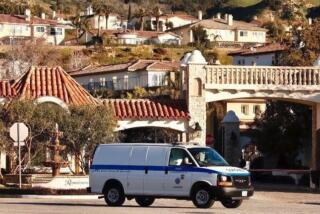Shoe Explosives Could Have Put Hole in Airliner
BOSTON — British bombing suspect Richard C. Reid had a potentially catastrophic mix of explosives in his shoes that, if ignited, could have blown a hole in the fuselage of the Miami-bound jet he boarded in Paris last week, authorities said Friday.
An FBI agent testified at a U.S. District Court hearing here that government scientists concluded that the shoes contained triacetone triperoxide, or TATP, a highly volatile material that has been used in previous terrorist bombing plots.
In Washington, a senior FBI official said the TATP was designed to be used as an “igniter chemical” for PETN, which was the main explosive. PETN is a key ingredient in Semtex, a plastic explosive that is a favorite of terrorists and was used to blow up Pan Am Flight 103 over Lockerbie, Scotland, in 1988.
The disclosures--and new information about Reid’s criminal history--came as a federal magistrate ordered him held without bail in a bizarre bombing plot. Authorities say he was foiled when other passengers wrestled him to the plane’s floor after flight attendants caught him trying to light wires protruding from his sneakers.
The information was the most detailed yet to emerge about the nature of the explosives Reid allegedly brought on board American Airlines Flight 63. But questions remain, including how Reid might have obtained the explosive material in his shoes, how he managed to pay for his flight and other extensive recent travels, and whether he acted alone or is part of a broader terrorist plot.
Reid was represented at the detention hearing by a federal public defender, Tamar Birckhead. She declined comment after the hearing.
In a seven-page ruling, U.S. Magistrate Judith Gail Dein said the evidence gathered so far against Reid is “very strong” and that he “poses an unacceptable and uncontrollable risk to the safety of others.”
Reid, 28, made no comment during the proceeding, his second courtroom appearance this week. His hands and feet shackled, he wore orange prison garb and leather sandals and spent most of the hearing leaning forward, his long locks dangling around his face.
He is charged with interfering with a flight crew, a felony for which the maximum penalty is 20 years in prison and a $250,000 fine. But authorities stressed Friday that an international investigation is underway and more serious charges are likely.
The FBI has launched “an aggressive, thorough investigation both here and abroad,” Charles S. Prouty, the special agent in charge of the FBI’s New England division, said after the hearing. “Our goal in the end is to know everything there is to know about Mr. Reid.”
FBI special agent Margaret Cronin, offering the bureau’s first public testimony, said the FBI’s forensic laboratory in Washington found TATP in Reid’s high-top shoes. Had he succeeded in igniting the material, Cronin said, FBI experts believe the damage to the plane could have been significant.
“If the sneakers had been placed against an outside wall, the potential for these sneakers--if he had blown them up--would have blown a hole in the fuselage,” Cronin said.
Reid was booked in a window seat in the 29th row of the aircraft, which carried 183 passengers and 14 crew members. It was diverted to Boston midway into the flight after passengers subdued Reid with tranquilizers and tied him to a seat with belts and plastic handcuffs.
Prosecutors also offered new details about Reid’s past, saying he has been in trouble with the law in Europe since his youth. His record includes 13 theft convictions, “offenses against persons on one occasion, and two offenses against property,” according to Dein’s ruling.
Prosecutors declined to elaborate on Reid’s criminal record.
U.S. Atty. Michael J. Sullivan said after the hearing that investigators have found no evidence that Reid had an accomplice on board the plane or on a flight the previous day, when he was detained for questioning by French officials.
But Sullivan declined to say whether investigators have been able to link Reid to Al Qaeda or other terrorist groups, even though evidence is emerging of such connections.
Detainees Report Reid Went to Terrorist Camp
Captured Al Qaeda members in Afghanistan have claimed that Reid attended a terrorist training camp there, although U.S. officials say they have not been able to corroborate those claims. And Reid, who converted to Islam while in prison, also attended the same Brixton mosque in London as Zacarias Moussaoui, a French citizen of Moroccan descent indicted by U.S. prosecutors in the Sept. 11 attacks on the World Trade Center and the Pentagon.
In a statement issued Wednesday, Birckhead, Reid’s attorney, said: “We are unaware of any evidence to support a link between the offense charged and any terrorist organization or individual.”
In Europe, meanwhile, there were new indications that Reid’s travels were consistent with those of Al Qaeda extremists. Investigators have determined that Reid was in Pakistan in August and attempted to renew his passport there, a European police official said Friday.
The British Foreign Office confirmed that Reid filed an application for a new passport at the British Embassy in Karachi, Pakistan, this year but did not pursue it.
“He did make an application in Karachi,” a Foreign Office spokeswoman said, declining to specify the month. “But he didn’t persist with it. He applied for a passport, but he didn’t follow it through for whatever reason.”
When Reid checked in for the Paris-to-Miami flight last week, he carried a new British passport issued Dec. 7 in Brussels and an old passport that expired in July, according to police. That raises a question about what document he would have used for a trip to Pakistan if he had been there in August.
In any case, Reid also traveled in July to Israel and Egypt. He flew on El Al, the Israeli airline known for its tough security screening. He was singled out for questioning and a search that included his shoes, airline officials have said, then allowed to board the plane. Investigators believe he flew El Al as a test to prepare himself for an eventual terrorist act.
In addition to already known trips sometime in 1999 or 2000 to Pakistan--the gateway to Al Qaeda’s training camps in Afghanistan for thousands of young extremists--investigators have detected additional trips to Pakistan as early as 1996, the European police official said. Reid speaks fluent Arabic, the official said.
The travel pattern reinforces suspicions that Reid trained at an Al Qaeda camp.
The investigation also has focused on leads that Reid went to the Netherlands to obtain the potent explosive compound used in his shoe bombs.
“The common assumption at this point is that he would have done it in Holland,” a Western law enforcement official said.
In Friday’s hearing, prosecutors portrayed Reid as a wanderer whose societal connections are virtually nonexistent. Arguing against granting Reid bail, Assistant U.S. Atty. Colin Owyang said Reid “has no verifiable address anywhere in the world.”
In her ruling, Dein said Reid claims he was never “officially” employed but worked briefly in construction and as a kitchen helper in Europe. Authorities offered no information about how Reid managed to pay for travel in Europe leading up to the Miami flight.
Birckhead did not dispute the charges against her client during the hearing. But she cross-examined Cronin, the FBI agent, for nearly an hour, probing for inconsistencies in the bureau’s account of the altercation on the plane and Reid’s arrest and interrogation afterward.
The hearing took place before a packed courtroom of journalists and observers, most of whom were required to remove their shoes for inspection before being allowed into the courthouse.
Birckhead began the hearing by asking that her client’s shackles be removed. But Dein rejected the request, saying, “I think, given the crowdedness of the courtroom, we’ll leave it as is.”
*
Greg Miller reported from Boston and Rotella from Paris. Times staff writers Marjorie Miller in London and Josh Meyer in Florida contributed to this report.
More to Read
Sign up for Essential California
The most important California stories and recommendations in your inbox every morning.
You may occasionally receive promotional content from the Los Angeles Times.









